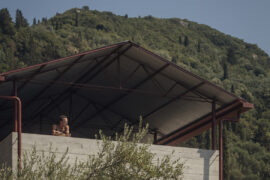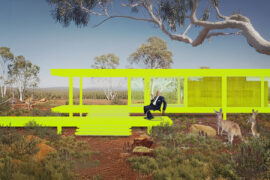British designer Morag Myerscough had to meet strict clinical regulations to bring her bright colours and harlequin prints to life in the Sheffield Children’s Hospital, not to mention entirely rethinking the idea of what healthcare spaces should look like.
Myerscough was invited by Artfelt, the Children’s Hospital Charity’s arts programme, to design the interiors for wards of the Sheffield Children’s Hospital.
The objective was to make the rooms feel more comfortable and domestic. Although children’s rooms might seem perfectly suited to Myerscough’s colourful, graphic style, the design process was not straightforward. Here, paler colour schemes we used to suit children with autism or others who have an intolerance to bright patterns.
She also wanted the rooms to feel appropriate to older children. Besides the colours and patterns, a defining feature of the space is its relative lack of medical equipment. A lot of the cables and devices are stored behind the Formica panels, giving the space a more comforting, home-like feel.
“Although the rooms are for children, I didn’t want them to be childish because children of all different age groups will be staying in them,” said Myerscough. “I also wanted to create somewhere parents would be happy to spend time too. It was just about making a bedroom that you felt good to be in.”
In addition, the hospital environment required that everything be sterile and easy to clean, so Myerscough had to work entirely with plastic laminate. The wood-like panels in the wards is Formica, which has the woodgrain screen-printed onto paper and then laminated. Painting directly onto the Formica wasn’t possible, and neither was screen-printing additional colours onto the paper.
“To get the really pure colours that I wanted, I had hoped to screen print my own pattern onto the existing wood grain,” Myerscough said. “Unfortunately we couldn’t do that because you can only screen print one or two colours onto the paper before it disintegrates.” In the end she ended up scanning the wood grain and digitally adding patterns to it. That combined pattern was then printed onto paper and laminated like normal Formica.
INDESIGN is on instagram
Follow @indesignlive
A searchable and comprehensive guide for specifying leading products and their suppliers
Keep up to date with the latest and greatest from our industry BFF's!

A longstanding partnership turns a historic city into a hub for emerging talent

The undeniable thread connecting Herman Miller and Knoll’s design legacies across the decades now finds its profound physical embodiment at MillerKnoll’s new Design Yard Archives.

Welcomed to the Australian design scene in 2024, Kokuyo is set to redefine collaboration, bringing its unique blend of colour and function to individuals and corporations, designed to be used Any Way!

For Aidan Mawhinney, the secret ingredient to Living Edge’s success “comes down to people, product and place.” As the brand celebrates a significant 25-year milestone, it’s that commitment to authentic, sustainable design – and the people behind it all – that continues to anchor its legacy.
On the eve of Brisbane Indesign, a unique collaboration will see Fortitude Valley’s Hynes Street come alive.
The internet never sleeps! Here's the stuff you might have missed

Dr Piers Taylor – award-winning British architect, BBC presenter and founder of Invisible Studio – returns to Australia to deliver a keynote at the inaugural Glenn Murcutt Symposium.

As the next event in a series of discussions centring on Richard Francis-Jones’ book comes to Brisbane, we hear directly from the speakers on fences, villas and the importance of critical community.